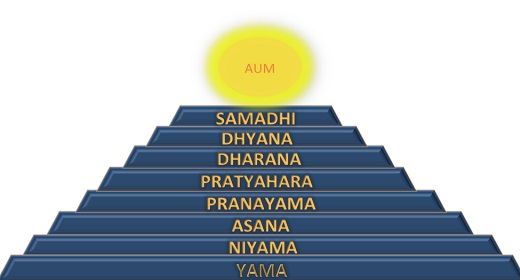by Swati: The meeting of Atman with the Paramatma in simple terms is Samadhi…
It is often considered the precursor of enlightenment. Each of us is a part of the universe. No matter what we begin as we end up in the oneness, the void or the unconsciousness. Samadhi is said to be achieved by using one of the various types of meditation techniques.
When the mind is fixed for understanding the self, it is said to be in Samādhi. According to Paramahansa Yogananda, Samadhi is a soundless state of breathlessness. The word can be broken down as sam, “together” or “integrated”; ā, “towards”; dhā, “to get, to hold”: “to acquire integration or wholeness, or truth” A blissful super consciousness state in which a yogi perceives the identity of the individualized Soul and Cosmic Spirit.
Hindu, Buddhists both have their own versions of attaining Samadhi, while yoga has its own path. Patanjali lists Samadhi as the eighth and final step on the path of yoga. Samadhi is often achieved through meditation. In this state, the three aspects of meditation — meditator, an act of meditation, the object of meditation known as God — are finally united.
Samadhi is regarded as the climax of all spiritual and intellectual activity. The power to attain Samadhi is a precondition of attaining release from the cycle of death and rebirth (samsara). Hence, the death of a person having this power is also considered a samadhi.
Sage Patanjali has elaborated eight limbs of yoga in his book Yoga Sutras as:
- Yam (Observances)
- Niyama (Abstinences)
- Asana (Postures)
- Pranayam (Breath controlling)
- Pratyahara (Withdrawal of senses)
- Dharana (Determination)
- Dhyana (Meditation)
- Samadhi (Self-realization or Nirvana per Buddhist philosophy).
But, what is Super Consciousness?
It is a state in which the soul realizes that it is much more than the conditioned body. Different types of higher states of consciousness can arise individually or in various combinations.
The list of known types of higher states of consciousness:
- modified states of consciousness, achieved with the help of meditative psychotechnics;
- optimal experience and the “flow” state;
- the euphoria of a runner;
- lucid dreaming;
- out-of-body experience;
- near-death experience;
- mystical experience (sometimes regarded as the highest of all higher states of consciousness)
Stages of Samadhi
Samprajnata Samadhi (Savikalpa)
The first level of samadhi is where you are peaceful, quiet, in meditation but you are available to the outside world. In this state, you are sitting quietly, consciously getting rid of disturbances of your mind and meditating. If some stimulus happens, you use your prajna (knowledge) to respond; that is the Samprajnata Samadhi.
Savikalpa samadhi is a state of conditioned oneness. The meditator experiences the merging of his soul with infinite consciousness; however, he cannot preserve the experience outside of meditation. It is simply a deepening of dhyana. Patanjali says that, for a short period of time, you lose all human consciousness. In this state, the concepts of time and space are altogether different.
However, this is not yet a permanent state and everybody has to return to ordinary consciousness. Patanjali describes the four stages of Savikalpa Samadhi are possible.
1. Sarvitarka Samadhi
This means “thought transformation on an object with the help of words.” Perhaps it is because so much of the everyday mind’s processes, including words, remain intact in this level of samadhi that many meditators do not recognize that they have in fact experienced Samadhi. It’s the stage of gaining knowledge. “Knowledge,” in yogic terms, always carries a sense of distinguishing the real from the unreal. In this stage, our thoughts transform to an object with the help of words and start a dialogue which is called Tarka. In the state of Savitarka Samadhi, the mind weigh things with awareness and decide whether they are useful to discuss or not.
2. Sa-Asmita Samadhi
This is the final stage of savitarka Samadhi. When the yogi becomes established in the one-pointed state of consciousness achieved in sananda samadhi the mind becomes even more purified, and is able to penetrate deeper. Even the ahankara, or ego-sense—despite its power, its pervasive nature, and its seeming solidity—is only a vritti, a single thought of individualized existence. This vritti too can be suppressed, and when this happens the yogi can directly perceive the source of the ahankara: the mahat.
3. Savichara Samadhi
Vichara samadhi (savichara and nirvichara) is described by Patanjali in sutras 1:44 and 45. “The state of samadhi concerned with subtle objects extends up to Prakriti, the source of all manifestation.” As savichara samadhi deepens, the yogi may begin to develop an understanding of the true nature of time and space and may also gain knowledge of certain aspects of the mahat, or cosmic mind. The mind (buddhi) experiences and explores the subtler level of the object through an alternation of awareness between its spatial, temporal, and causal aspects.
After some practice, the yogi will be able to fully transfer consciousness from the vitarka to the vicara level. Savichara Samadhi is a state of silence in which thinking is available, but the mind is quiet.
4. Sa-Ananda Samadhi
Here the mind is devoid of the objective world, you move beyond the intellect. There is no reasoning or reflection, just the tranquillity of the settled mind. The sattvic (pure) mind is only aware of its own joy. The focus is on the inner powers of perception and within the mind itself. It’s known as a “blissful” Samadhi filled with joyful peace.
Asamprajnata Samadhi (Nirvikalpa)
The second level of Samadhi is when you go deeper into yourself, away from the world outside and if some stimulus happens, it won’t affect you. This is Asamprajnata Samadhi. In Mahabharata, Arjuna is supposed to have practised his archery with such a concentration.
The only thing present at this stage is pure, empty consciousness: only self-aware being. This is Nirvikalpa or Nirbija samadhi. The mind of the yogi who attains to take on some of the omniscient and omnipotent qualities of the cosmic. The yogi who is able to navigate this stage eventually attains discriminative wisdom and perfect purity of mind and surrenders all attachments.
The Nirbija samadhi is also referred to as Nirvikalpa Samadhi. Sri Ramakrishna, Raman Maharshi, Sri Yukteswar Giri, and Swami Vivekananda is said to have experienced the state of Nirvikalpa and reached to Nirbija Samadhi.
Nirvitarka Samadhi
It refers to the state in which the mental alternations of shabda, artha, and jñana are suspended. The less-real components, shabda and jñana, fall away completely, while the mind is absorbed in only artha, or form, and loses its awareness of being the knower. Its where we have greater control over mind, ideas, intellect and dialogues. The memory about the nature of the object (its identifying sound and the accumulated knowledge) are temporarily transcended during Nirvitarka samadhi.
Nirvichara Samadhi
For the first time, true one-pointed concentration becomes possible. Even subtle thoughts do not occur. The perceptual limitations of time and space are transcended; this state is called Nirvichara Samadhi.
Kaivalya Samadhi
The final stage is to reach Kaivalya Samadhi: complete, final, and eternal union with the real, eternal form.
Step by Step process into Samadhi
- The first step, Dharana, is loosely translated as “concentration.” The Yoga Sutra gives a specific definition of this word: “to confine the mind or fix it in a well-defined space.” Space is infinite. Because it does not have shape, colour, or form, identifying space is very difficult. Therefore, to confine the mind to space, you have to first separate it from the rest of infinite space by putting a border around it
- Vyasa, the foremost commentator on the Yoga Sutra, advises bringing the mind to a space that is well defined, such as the area around your navel centre, the heart centre, the centre between the eyebrows, or to a particular external point, such as a flame or a particular image.
- You must then select an object to occupy that space be it an image of Ganesha, a yantra, or a mantra.
- Distraction is the mind’s tendency to contact various objects at a fast speed and forget both the main object it was supposed to be aware of and the space in which it was supposed to be confined. Rather than giving in to the habit of distraction, bring your mind back to the chosen object and allow your mind to focus on that, repeatedly.
- Concentration and distraction flow side by side. The only difference is that one stream—the stream of concentration—is stronger, heavier, and fuller than the other.
- As concentration matures, it turns into meditation or dhyana. This is the second step. So dhyana is a continuation of Dharana; your meditation is a more mature state of your concentration.
- Many saints and yogis say that if your mind remains concentrated on one object for at least 12 breaths, you have achieved a state of meditation. If within that 12-breath period, your mind shifts from one object to another object, you are still at the stage of concentration.
Samadhi dawns when your mind becomes completely absorbed in the object occupying the space to which you have confined it. In samadhi, the process of concentration, the object of concentration, and the mind that is trying to concentrate or meditate all have become one. In samadhi, you are aware only of the essence and not of the details.

























































